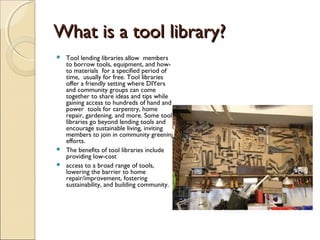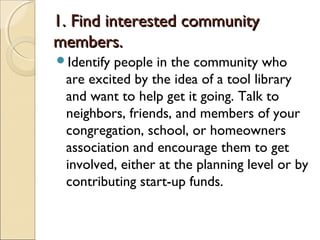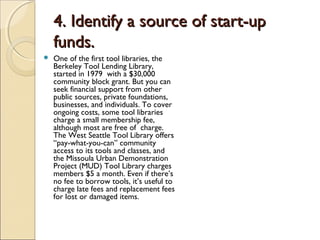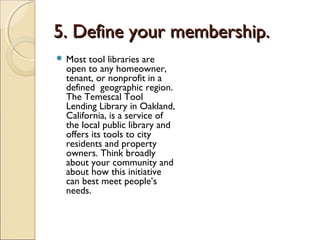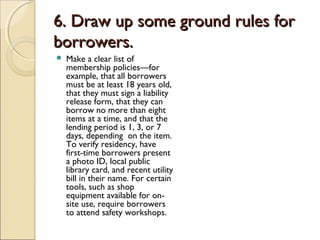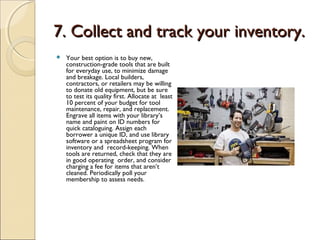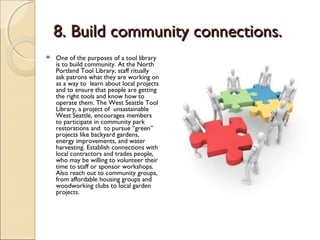ą┐čĆąŠąĄą║čé ą▒ąĖą▒ą╗ąĖąŠč鹥ą║ą░ ąĖąĮčüčéčĆčāą╝ąĄąĮč鹊ą▓
- 1. ą¤čĆąŠąĄą║čé ┬½ąæąĖą▒ą╗ąĖąŠč鹥ą║ą░ą¤čĆąŠąĄą║čé ┬½ąæąĖą▒ą╗ąĖąŠč鹥ą║ą░ ąśąĮčüčéčĆčāą╝ąĄąĮč鹊ą▓┬╗ ą│. ąæą░čĆą░ąĮąŠą▓ąĖčćąĖąśąĮčüčéčĆčāą╝ąĄąĮč鹊ą▓┬╗ ą│. ąæą░čĆą░ąĮąŠą▓ąĖčćąĖ Social Weekend 6
- 2. What is a tool library?What is a tool library? ’éŚ Tool lending libraries allow members to borrow tools, equipment, and how- to materials for a specified period of time, usually for free. Tool libraries offer a friendly setting where DIYers and community groups can come together to share ideas and tips while gaining access to hundreds of hand and power tools for carpentry, home repair, gardening, and more. Some tool libraries go beyond lending tools and encourage sustainable living, inviting members to join in community greening efforts. ’éŚ The benefits of tool libraries include providing low-cost ’éŚ access to a broad range of tools, lowering the barrier to home repair/improvement, fostering sustainability, and building community.
- 3. 1. Find interested community1. Find interested community members.members. ’éŚIdentify people in the community who are excited by the idea of a tool library and want to help get it going. Talk to neighbors, friends, and members of your congregation, school, or homeowners association and encourage them to get involved, either at the planning level or by contributing start-up funds.
- 4. 2. Hold a meeting and2. Hold a meeting and designate a core team.designate a core team. ’éŚAt your first meeting, discuss your vision for the library as well as the projectŌĆÖs basic parameters. How many tools do you want to offer at first? Do you want to provide workshops or workspace? What are the options for locations? Identify a core team to develop the project and designate key roles such as a financial and legal expert, a membership and outreach coordinator, a volunteer coordinator, and a tool coordinator.
- 5. 3. Set up the organizational3. Set up the organizational structure.structure. ’éŚ Decide what form your library will take. Should it be its own nonprofit, a project of an existing organization like a public library or neighborhood association, or a more informal initiative maintained by motivated volunteers? Silicon Valley PowerŌĆÖs Tool Lending Library, which specializes in tools that help residents save energy, is hosted by the local utility in Santa Clara. Also, consider your staffing needs: having at least one paid staffer (the tool coordinator) is helpful to keep operations running smoothly.
- 6. 4. Identify a source of start-up4. Identify a source of start-up funds.funds. ’éŚ One of the first tool libraries, the Berkeley Tool Lending Library, started in 1979 with a $30,000 community block grant. But you can seek financial support from other public sources, private foundations, businesses, and individuals. To cover ongoing costs, some tool libraries charge a small membership fee, although most are free of charge. The West Seattle Tool Library offers ŌĆ£pay-what-you-canŌĆØ community access to its tools and classes, and the Missoula Urban Demonstration Project (MUD) Tool Library charges members $5 a month. Even if thereŌĆÖs no fee to borrow tools, itŌĆÖs useful to charge late fees and replacement fees for lost or damaged items.
- 7. 5. Define your membership.5. Define your membership. ’éŚ Most tool libraries are open to any homeowner, tenant, or nonprofit in a defined geographic region. The Temescal Tool Lending Library in Oakland, California, is a service of the local public library and offers its tools to city residents and property owners. Think broadly about your community and about how this initiative can best meet peopleŌĆÖs needs.
- 8. 6. Draw up some ground rules for6. Draw up some ground rules for borrowers.borrowers. ’éŚ Make a clear list of membership policiesŌĆöfor example, that all borrowers must be at least 18 years old, that they must sign a liability release form, that they can borrow no more than eight items at a time, and that the lending period is 1, 3, or 7 days, depending on the item. To verify residency, have first-time borrowers present a photo ID, local public library card, and recent utility bill in their name. For certain tools, such as shop equipment available for on- site use, require borrowers to attend safety workshops.
- 9. 7. Collect and track your inventory.7. Collect and track your inventory. ’éŚ Your best option is to buy new, construction-grade tools that are built for everyday use, to minimize damage and breakage. Local builders, contractors, or retailers may be willing to donate old equipment, but be sure to test its quality first. Allocate at least 10 percent of your budget for tool maintenance, repair, and replacement. Engrave all items with your libraryŌĆÖs name and paint on ID numbers for quick cataloguing. Assign each borrower a unique ID, and use library software or a spreadsheet program for inventory and record-keeping. When tools are returned, check that they are in good operating order, and consider charging a fee for items that arenŌĆÖt cleaned. Periodically poll your membership to assess needs.
- 10. 8. Build community connections.8. Build community connections. ’éŚ One of the purposes of a tool library is to build community. At the North Portland Tool Library, staff ritually ask patrons what they are working on as a way to learn about local projects and to ensure that people are getting the right tools and know how to operate them. The West Seattle Tool Library, a project of unsastainable West Seattle, encourages members to participate in community park restorations and to pursue ŌĆ£greenŌĆØ projects like backyard gardens, energy improvements, and water harvesting. Establish connections with local contractors and trades people, who may be willing to volunteer their time to staff or sponsor workshops. Also reach out to community groups, from affordable housing groups and woodworking clubs to local garden projects.
- 11. 9. Spread the word!9. Spread the word! ’éŚ Develop a media and outreach strategy as a day to get people excited and involved. Reach out to reporters, and send them announcements when you hit a milestone. Encourage library patrons to document their projects and share their stories with others. Most importantly, advertise your services so folks will want to use the library and support your efforts.
- 12. 10. Celebrate your successes10. Celebrate your successes ’éŚ As more people use the library, continue to celebrate your successes. Host a neighborhood-wide green celebration to acknowledge your hard work and raise awareness of your efforts, so more people will want to become involved. Above all, donŌĆÖt forget to have fun with what youŌĆÖre doing!

